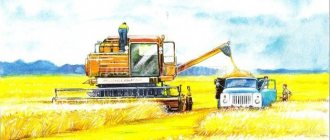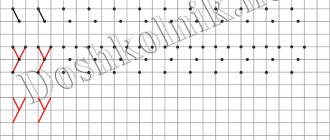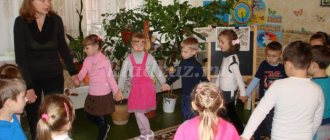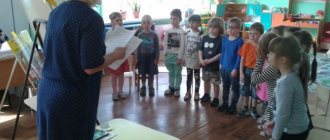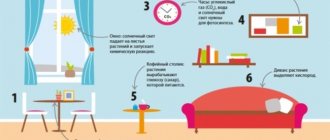Card index of conversations on environmental topics - raising conscious children
Greetings to all my readers! With you, as usual, is the owner of the blog, Tatyana Sukhikh. One reader asked me to share ideas about what issues could be raised in conversations with preschoolers about garbage and cleanliness. So I decided to tell you what topics my file of conversations on environmental topics contains.
Conversation is the most important method of working with children
There are two ways to provide useful information, instill good habits, and give children the skills to do something: talk to kids about pressing topics and set a personal example. If we talk about ecology, then the education of a responsible citizen begins with our personal example and well-constructed conversations filled with emotional examples.
In kindergarten, we “talk” with children all the time, but we don’t limit ourselves to moralizing, but try to make the conversation interesting, instructive and productive. It is clear that garbage is not the only topic of conversation within environmental education. Below I will provide a list of sample topics for all ages.
It is worth saying that the conversation itself is rarely used as an independent method, but it is an obligatory component of any educational moment in a preschool educational institution.
Thus, we distinguish between introductory conversations that organize children to perform one or another type of activity, accompanying conversations during a process or activity, and final or clarifying conversations.
In addition, a distinction is made between cognitive and ethical conversations.
Therefore, the list of topics about ecology from the card index, which I will give below, can be used not only as part of thematic classes on environmental education, a month or week of ecology, but also during walks, when we observe nature, during organizational moments and on special occasions. , if an incident occurs that can be resolved through conversation, for example, a child picked flowers or broke a branch of a tree.
I will also add regarding conversation as the main, in my opinion, method of the educational process, that it is important to understand the power that the human word has. It wounds and heals, lifts you from your knees and kills.
Remember that children absorb literally every statement you make and clearly understand the difference between what you say and how you act in real life.
If you throw cigarette butts and pieces of paper on the sidewalk, there’s no point in moralizing about ethical issues...
List of topics for conversations within environmental education
So, I give a list of topics, and remember that it is suitable for any age, but, naturally, the information content must strictly correspond to the age of the child.
What is clear to the preparatory group will be absolutely incomprehensible to the kids. Next, I will roughly describe what a card from an ecology card index looks like.
And, of course, I’ll give you a tip on a good thematic guide: “Conversations based on pictures “Lessons of Ecology.” Demonstration material. (16 pictures + 8 diagrams).”
Topics of conversation on ecology:
- People are friends of nature;
- You need to be able to feel sorry;
- Amazing all around;
- Forest: love, protect and not be afraid;
- Secrets of plants;
- Birds and animals in winter;
- Pharmacy in the meadow;
- Do animals have houses?
- How can we help nature;
- All living things are under our protection;
- Insects are part of nature;
- Garbage is a disease of the planet;
- Don't pollute nature!
- Kindness must be learned;
- Our home is nature;
- Our helpers are birds;
- Nature in art;
- Fire: friend or foe?
As you noticed, the names of the topics are universal, they are suitable for classes on ecology in the second junior group, and 1st grade will also find something to talk about.
How to design environmental conversation cards
Let’s take the topic: “Don’t pollute nature!” in the older group. We write down the topic on a card, then write down the goals of the conversation:
- Emphasize the problem of human pollution of nature;
- Explain how people pollute the environment: garbage, landfills, water and air pollution;
- Ensure that preschoolers understand the relevance of the problem;
- Together with children, determine ways to solve the problem of environmental pollution.
1. Introductory conversation about the existence of the problem of environmental pollution. Questions for children and expected answers:
— How do people pollute nature? (Garbage, exhaust gases, industrial waste);
— Where does household waste go from apartments and houses? (They take the garbage cars to the landfill);
— What happens to the garbage at the landfill? (Rots, decomposes, emits terrible odors, gathers hordes of rodents, its number is growing);
— How to reduce landfills? (Buy less unnecessary things, sort garbage, recycle paper, glass, compost food waste);
— What can be made from waste paper and glass? (New paper, glass products);
— What other types of waste are there? (Metal, construction, plastic);
- What can be done with them? (Recycle and reuse);
-What do you children throw in the trash can? (Candy wrappers, broken and old toys);
— How to reduce the amount of waste? (Donate unnecessary toys to charity, try to fix broken ones and reuse them, sort other garbage);
— Why do we need waste processing plants? (To recycle and reduce waste).
2. Demonstration of slides about products made from recycled materials.
- What can be made from ordinary garbage? (Paper products, glass, old unnecessary things can be used to make new toys, interior items, crafts and even entire houses);
3. Outdoor game “Who can collect the pieces of paper faster” and “Sorting the garbage.”
4. Drawing on the theme “Garbage and nature.”
5. Closing conversation
- What did we talk about today? (About environmental pollution, waste recycling, recycled products);
- What conclusion can be drawn? (You need to take care of nature, do not litter and try to reduce the amount of waste, give a second life to unnecessary things).
What else should I add?
Using the same principle, you need to think through questions and answers on all topics. Within the framework of the article, I don’t see the point in writing “cheat sheets” on each topic. It’s actually not difficult, the main thing is to know what to talk about with your children. If you really don’t have time, you can buy ready-made cards.
Conversations with children of the senior and preparatory groups are carried out as a separate type of educational process and as during other types of activities.
For the younger and middle groups, it is better to talk with children during walks, art classes, etc. And be sure to use life situations to instill in children a reasonable and caring attitude towards the world around them. And let’s not forget to include parents in the work; we consult with them and talk about the same topic.
I hope my tips were useful? If so, share with those who may also find them useful, and please subscribe to the news.
Sincerely, Tatyana Sukhikh! Till tomorrow!
By the way, I recommend reading:
Greetings, dear readers of my blog! I'm with you again...
Hello my good readers! Tatyana Sukhikh is with you today...
Source: https://metodbv.ru/kartoteka-besed-na-ekologicheskuyu-temu/
| OO | Social and communicative development | Cognitive development | Speech development | Artistic and aesthetic development | Physical development |
| 1 p.d. | Conversation “How I save nature.” Goal: to involve children in environmental activities. | Watch the video “Our days in kindergarten.” Goal: remember the main events in the lives of children in kindergarten. | Di. “Pick a verb.” Goal: to consolidate children’s knowledge about the actions of the educator and teacher. | Making prom invitations. Goal: to show children the importance of the upcoming event. | Physical activity of the children's choice. Goal: repeat familiar physical exercises, words and movements. |
| Walk | Work in the garden. Goal: to strengthen the ability to work with a rake. | Watching a thunderstorm. Goal: to introduce the concept of “thunderstorm”, to form real ideas about natural phenomena, to enrich vocabulary. | Conversation “What do I want to be when I grow up?” Goal: to deepen children’s understanding of the lives of adults, to develop respect for people of different professions. | Work with the album “Theatres of the World”. Goal: to expand knowledge about theaters in different countries, to encourage staging. | Relay race “Who will collect the briefcase faster?” Goal: to consolidate the rules of the relay race, to develop physical qualities. P.i. "Mousetrap". Goal: remember the rules of the game. |
| OD | |||||
| 2 p.d. | Work assignments. Goal: improve the ability to completely make the bed after sleep. | Cognitive and research activities “Candle in a Jar”, “Live Snake”. Goal: consolidate knowledge about the properties of air, determine the percentage of oxygen and other substances in the air. | Reading fiction about kindergarten at the teacher's choice. Goal: remember interesting moments from life in kindergarten. | Drawing “School of the Future”. Goal: to consolidate the ability to convey the features of architectural styles in a drawing, to develop imagination. | A story about a physical education lesson at school. Goal: expand knowledge about school subjects. |
Tuesday | |||||
| OO | Social and communicative development | Cognitive development | Speech development | Artistic and aesthetic development | Physical development |
| 1 p.d. | Problem situation “Forgotten package”. Goal: to form the basis of safe behavior. | Virtual excursion to school. Goal: to expand children’s knowledge about school subjects, to create a desire to study at school. | Game "Letters mixed up." Goal: to train children in making words from letters. | Games in the "Museum of Letters". Goal: to maintain interest in learning to read and write, to encourage dramatizations with letters. | Learning a counting rhyme (Mikhalkov’s poem “Kittens”). Goal: develop memory, strengthen counting skills. |
| Walk | Socially useful work. Goal: to develop the ability to work together in a team of peers. | Board game “Fold the square”. Goal: to consolidate the ability to fold a square from different parts without relying on a sample. | Articulation gymnastics at the teacher's choice. Goal: to improve the sound culture of speech. | Dramatization of favorite fairy tales. Goal: to create conditions for the manifestation of creative abilities in children. | P.i. "We are funny guys." Goal: improve running skills, develop auditory attention. P.i. according to children's choice. Goal: improve physical skills. |
| OD |
Thematic week “Goodbye, kindergarten!” preparatory group, May
The school year is coming to an end and, according to the program “From Birth to School” edited by N.E. Veraksy, the last week of May is dedicated to saying goodbye to kindergarten and expanding children’s knowledge about school life.
The teacher organizes a virtual excursion to the school, talks about school subjects, and the profession of a teacher. Preschoolers reflect the acquired knowledge in role-playing and interactive games, and decorate the group for graduation.
Games and conversations about school, poems for the holiday and much more on the theme of the week can be found in the appendix to the plan “Thematic week “Goodbye, kindergarten!”.
Social and communicative development
In the field of social and communicative development, activities are planned aimed at developing a sense of gratitude and respect for kindergarten staff and the work of adults.
Future schoolchildren repeat the rules of safe behavior at home and in nature, learn about the lives of people with disabilities, participate in socially useful work and talk about how their actions can preserve nature.
Cognitive development
In the field of cognitive development, it is planned to examine a map of Russia, a conversation about the country and its riches, as well as a conversation about a spring, a study of the properties of air, and observations in nature. Preschoolers, together with their parents, prepare messages about those who work at school and produce a wall newspaper “Our days in kindergarten.”
Speech development
Work on speech development continues in games and exercises, composing riddles on various topics, conversations “What do I want to become when I grow up,” “What can a teacher teach,” etc. Every day the teacher reads literary works about school to the children and learns poems for the prom.
Artistic and aesthetic development
Preschoolers make invitation cards to the prom and participate in the decoration of the group. The game “Where we were, we won’t say, but what we did, we’ll show you”, the application “Round Dance of Friendship” contribute to artistic and aesthetic development in the same way as game exercises according to the TRIZ system.
Physical development
In the area of physical development, conversations about teeth, their importance and diversity in animals, dominoes “Healthy Products”, various relay races and outdoor games on the topic of the week are planned.
Monday
(23 4,87 out of 5)
Dear teachers, when you pay for the plan, a download link is sent to your email (Email). Depending on your email settings, the letter may end up in the Spam folder, please check!
If you have any questions, write to us at [email protected]
You can buy a plan for the whole year on the page “How to purchase a calendar plan?”
Be careful when filling out the order form, write your email without errors!
Source: https://KalendarnyiPlan.ru/kalendarnyj-plan-na-maj-podgotovitelnaya-gruppa-4-nedelya
